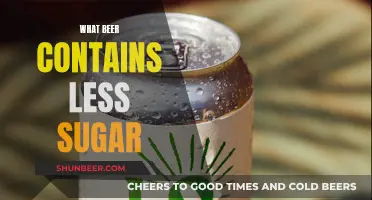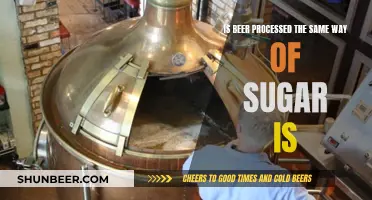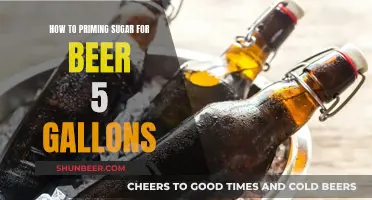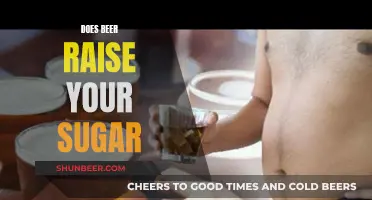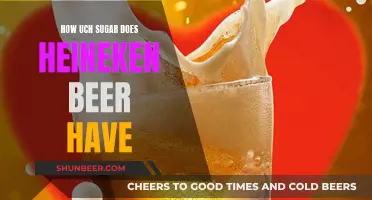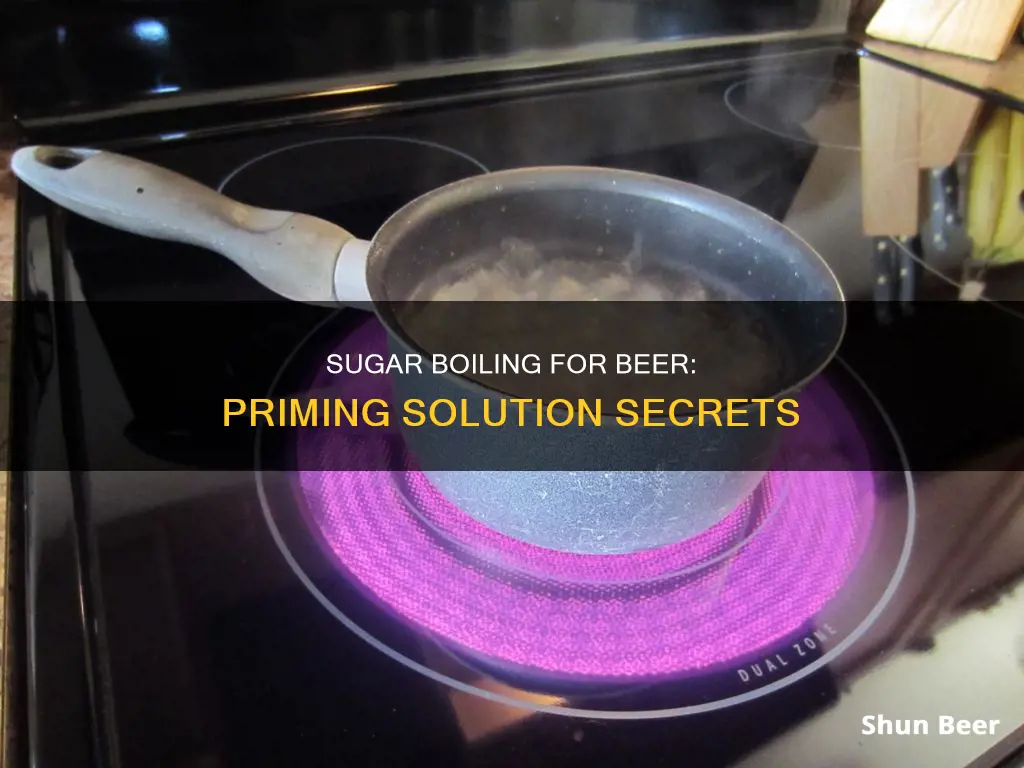
When it comes to bottling beer, priming is an essential step in the process. Priming sugar is added to the brew during bottling to create carbonation, giving beer its trademark fizz and foam. The sugar is boiled in water to create a priming solution, which is then added to the bottling bucket with the beer. The yeast in the beer then feeds on the sugar, creating carbon dioxide gas, which is trapped in the bottle, resulting in carbonation. This process is known as bottle priming or bottle conditioning, and it is a crucial step for any homebrewer looking to create a refreshing, bubbly beer with the right amount of carbonation.
What You'll Learn
- Boiling sugar creates a solution that can be added to the beer to aid carbonation
- The sugar is food for the yeast, which creates carbon dioxide
- The carbonation gives the beer its fizz and improves the taste
- Different types of sugar require different calculations for maximum efficacy
- Boiling sugar is a simple process that improves the chances of high-quality carbonation

Boiling sugar creates a solution that can be added to the beer to aid carbonation
Boiling sugar is an essential step in creating a priming solution for beer, as it aids in the carbonation process and ensures a refreshing, bubbly beverage. Carbonation is a critical aspect of beer, giving it its trademark fizz, foamy head, and enhancing its aroma, taste, mouthfeel, and overall appearance.
Priming sugar, typically corn sugar (dextrose) or table sugar (sucrose), is boiled in water to create a solution that can be added to the beer during bottling. This process is known as bottle priming. The boiled sugar solution provides food for the yeast, which then converts the sugar into carbon dioxide (CO2), creating carbonation. The yeast leftover from the fermentation process feeds on the added sugar, producing CO2 gas that is trapped inside the sealed bottles, resulting in carbonation.
The amount of priming sugar used depends on the desired level of carbonation and the type of sugar. Brewers need to be cautious to avoid "bottle bombs," which occur when excess pressure builds up in the bottles due to improper priming. Calculating the precise amount of priming sugar required is crucial to ensure the desired carbonation level without creating dangerous pressure.
The process of creating a priming solution is straightforward. Brewers bring water to a boil, add the priming sugar, and stir until it dissolves completely. The mixture is then cooled before being combined with the beer in a bottling bucket. The beer is carefully transferred from the fermenter to the bottling bucket, taking care to avoid oxidation by splashing.
By boiling sugar and creating a priming solution, brewers can effectively carbonate their beer, enhancing its overall quality and delivering a delightful drinking experience.
Sugar's Sweet Impact: Brewing Beer's Complex Science
You may want to see also

The sugar is food for the yeast, which creates carbon dioxide
The final step in brewing beer is priming, which gives beer its carbonation, foamy head, and improves its aroma, taste, mouthfeel, and overall appearance. This is done by adding a priming solution to the brew as it is bottled. The priming solution is typically made by dissolving sugar in boiling water. The sugar in the priming solution serves as food for the yeast, which creates carbon dioxide (CO2) as it is consumed by the yeast, resulting in bubbles in the brew.
Yeast leftover from the fermentation process consumes the sugar in the bottle, producing carbon dioxide gas. This gas is trapped inside the bottle, creating carbonation. This is the same process that produces air bubbles in an airlock during fermentation, but in this case, the carbon dioxide is intentionally trapped to create carbonation.
The amount of priming sugar added to the beer will depend on the desired level of carbonation, with most beers falling between 2.0 and 3.0 volumes of CO2. The Brewer's Friend Beer Priming Calculator can be used to determine the exact amount of priming sugar needed based on the volume of beer, desired CO2 volume, and temperature of the beer.
Different types of sugar can be used for priming, such as corn sugar, table sugar, or dry malt extract. Corn sugar is a common choice due to its high fermentability, low moisture content, and neutral flavour. Table sugar is also a good option as it is less expensive and widely available. However, it should be used in smaller quantities than corn sugar as it contains no water.
The process of priming is simple but requires attention to detail to avoid creating "bottle bombs", which are bottles of beer that have exploded due to excess pressure from the priming process. Proper sanitation and careful handling of the beer are crucial to avoid this issue.
Beer vs. Whiskey: Sugar Content Face-off
You may want to see also

The carbonation gives the beer its fizz and improves the taste
Carbonation is an essential part of the beer-making process, giving beer its distinctive fizz and improving its taste and mouthfeel. It is the process of dissolving carbon dioxide gas in the beer, which is achieved by sealing the beer in a container under pressure. When the pressure is released, the carbon dioxide rises to the top in the form of bubbles or carbonation. This process gives beer its refreshing quality.
Carbonation can be achieved through natural or forced carbonation. In both methods, beer and carbon dioxide are sealed in a container under pressure, allowing the beer to absorb the gas. Natural carbonation occurs during the fermentation process, where yeast digests the sugar in the wort, producing alcohol and carbon dioxide. The brewer seals the beer in a container when fermentation is almost complete, trapping the carbon dioxide and creating natural carbonation. This method is often used for casks and holding vessels at breweries.
Another way to naturally carbonate beer is through bottle conditioning. In this process, the beer is allowed to ferment completely, leaving active yeast suspended in it. A small amount of sugar is added at bottling, and once the bottles are sealed, the yeast feeds on the sugar, releasing carbon dioxide that is absorbed by the beer.
Forced carbonation, on the other hand, involves pumping carbon dioxide into a sealed container with the beer. This method is commonly used for kegs, and the beer is refrigerated during the process. After a few days, the carbon dioxide is fully absorbed into the beer, resulting in complete carbonation.
The level of carbonation can vary depending on the style of beer and personal preference. For example, malty beers generally take less carbonation, while hoppy beers benefit from more. Additionally, darker lagers can be smooth with moderate carbonation. Priming sugar calculations and carbing to style are important considerations to ensure the desired level of carbonation is achieved.
Carbonation not only enhances the taste of beer but also has a unique flavour of its own. It can bring out bitterness and reduce sweetness, affecting the overall taste profile of the beer. The fizziness of carbonation also contributes to the mouthfeel of the beer, making it a crucial aspect of the beer-drinking experience.
Shiner Beer: Sugar Content and Nutritional Facts
You may want to see also

Different types of sugar require different calculations for maximum efficacy
When it comes to priming your brew, understanding the ins and outs of priming sugar is essential to making sure your careful craftsmanship and hard work pay off. The priming sugar you use is entirely up to you. Three of the most popular types of sugar used to create priming solutions are corn sugar (dextrose), table sugar (sucrose), and dry malt extract (DME). While all three provide a source of tasty nutrition for the yeast that will carbonate your brew, each requires a special calculation for maximum efficacy as a primer.
Corn Sugar (Dextrose)
The most popular priming sugar, standard corn sugar is roughly 9% water, which means only 91% of its mass can be used in calculating the carbonation it will generate. This gives us the following formula:
CF + .5 x (.91D)/VB = CB
Where:
- CF is the level of CO2 in your flat brew (in grams/litre), known as volumes or “vols” in the Imperial system.
- D is the amount of corn sugar (in grams).
- VB is the volume of your brew (in litres).
- CB is the carbonation level of your finished beer (in litres), known as volumes or “vols” in the Imperial system.
Table Sugar (Sucrose)
Unlike corn sugar, table sugar has no water content, so we simply apply the “fifty per cent” rule and multiply the amount of sugar by one half in our formula:
CF + .5(S)/VB = CB
Where:
- CF is the level of CO2 in your flat brew (in grams/litre).
- S is the amount of table sugar (in grams).
- VB is the volume of your brew (in litres).
- CB is the carbonation level of your finished beer (in grams/litre).
Using Dry Malt Extract (DME)
This primer requires a bit more calculation to find the correct amount of carbonation it will create. In addition to the amount, you’ll also need to know the fermentability of your DME, which is also known as the limit of attenuation. This is the amount of material in the DME the yeast in your brew can digest and convert during the final fermentation.
Many DME brands sold commercially will list their fermentability on the package or product sheet. This is known as the apparent fermentability or apparent attenuation. However, to ensure optimal quality, it’s a good idea to multiply the apparent fermentability by .82 to find a value we call the true fermentability, or true attenuation, like so:
FA x .82 = FT
Where:
- FA is the apparent fermentability.
- FT is the true fermentability.
Once you know the true fermentability, you can plug it into your calculations for your target carbonation, as follows:
CF + .5FTx (X/VB) = CB
Where:
- CF is the level of CO2 in your flat brew (in grams/litre).
- FT is the true fermentability of the DME.
- X is the amount of DME (in grams).
- VB is the volume of your brew (in litres).
- CB is the carbonation level of your finished beer (in grams/litre).
Cider vs Beer: Which Has More Sugar?
You may want to see also

Boiling sugar is a simple process that improves the chances of high-quality carbonation
Boiling sugar is a straightforward process that can improve the likelihood of achieving high-quality carbonation in your beer. This process, known as bottle priming, is essential to give your beer its trademark carbonation, foamy head, and desirable characteristics in aroma, taste, mouthfeel, and appearance.
To begin, you'll need to select the type of sugar you want to use. Common choices include corn sugar (dextrose), table sugar (sucrose), or dry malt extract (DME). Each of these options has its own advantages, such as high fermentability and neutral flavour in the case of corn sugar, or lower cost and convenience in the case of table sugar.
Once you've chosen your sugar, the process of boiling is quite simple. Combine the sugar with water in a pot and bring it to a medium-high heat. Stir the mixture until the sugar is completely dissolved. Then, continue boiling for about 5 minutes. Afterward, remove it from the heat, cover the pot, and let the solution cool down.
This boiling process is important for several reasons. Firstly, it helps to ensure that the sugar is fully dissolved in the water, creating a consistent solution. This consistency is crucial for achieving even carbonation throughout your beer. Additionally, boiling sterilizes the sugar, reducing the risk of introducing unwanted bacteria or wild yeast that could affect the flavour and safety of your beer.
After the solution has cooled, you can transfer your beer from the fermenter into the pot with the priming solution, gently stirring to combine the two. At this point, your beer is ready to be bottled and will undergo a final fermentation in the bottles, resulting in the desired carbonation.
By following these simple steps, you can significantly improve the chances of achieving high-quality carbonation. The process of boiling sugar is straightforward, but it plays a critical role in ensuring your beer develops the bubbles and flavour characteristics that make it enjoyable to drink.
India Pale Ale: Sugar Content and Its Influence
You may want to see also
Frequently asked questions
Priming sugar is essential to making sure your beer is carbonated. It is the main component in the priming solution and gives your beer its trademark carbonation, foamy head, and can significantly benefit the aroma, taste, mouthfeel, and overall appearance.
Plain table sugar, brown sugar, honey, dry malt extract (DME), Belgian candi syrup, molasses, maple syrup, treacle, agave nectar, and demerara sugar can all be used as priming sugar alternatives.
A good all-purpose amount for a 5-gallon batch of beer is 5 ounces (142 grams) of corn sugar.
Bottle priming involves mixing dissolved sugar with beer, transferring it to bottles, and securing those bottles with an airtight seal. The yeast left over in the beer from fermentation eats away at the added sugar in the bottle and produces carbon dioxide gas, which remains in the beer until it’s ready to pour.
Boiling the priming solution helps dissolve the sugar fully to ensure an even distribution in the bottling vessel. It also helps sanitise the sugar and remove dissolved oxygen from the water.


